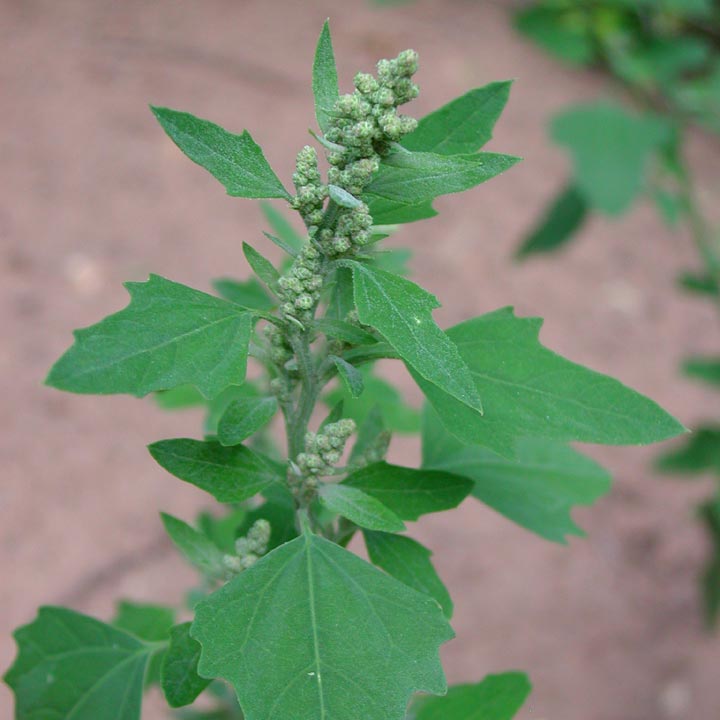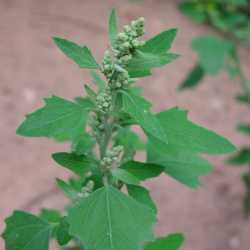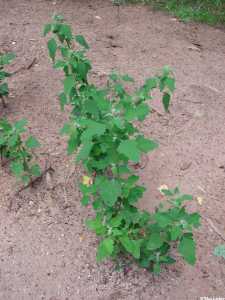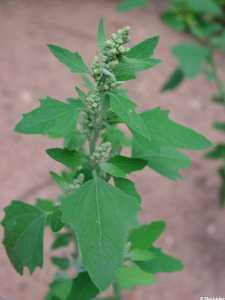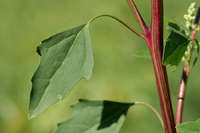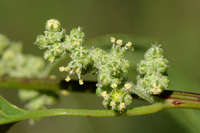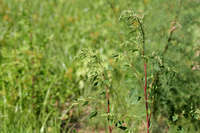Stems erect to sprawling, simple to much-branched, 1-30 dm, sparsely to densely farinose. Leaves nonaromatic; petiole 1-2.5 cm, shorter than blades or occasionally longer; blade ovate-lanceolate to rhombic-lanceolate or broadly oblong, 1-5.5(-12) × 0.5-3.8(-8) cm, base narrowly to broadly cuneate, margins sinuous-dentate to shallowly serrate or entire, apex acute to subobtuse, farinose abaxially. Inflorescences glomerules or occasionally 1-flowered peduncles in terminal and lateral compound spikes, 2-19 cm; glomerules subglobose, 3-4 mm diam.; bracts absent. Flowers: perianth segments 5, distinct nearly to base; lobes ovate, ca. 1 × 1.1 mm, apex obtuse, keeled, farinose, largely covering fruit at maturity; stamens 5; stigmas 2, 0.2-0.3 mm. Utricles depressed-ovoid; pericarp nonadherent, occasionally adherent, smooth to papillate. Seeds lenticular, margins round, 0.9-1.6 mm diam.; seed coat black, smooth, indistinctly granulate and/or radially grooved, or with faint reticulate-rugose ridges. 2n = 54.
Fruiting late summer-fall. Disturbed soils in open habitats; 0-1400 m; introduced; Alta., B.C., Man., N.B., Nfld. and Labr., N.W.T., N.S., Nunavut, Ont., P.E.I., Que., Sask., Yukon; Ala., Alaska, Ariz., Ark., Calif., Colo., Conn., Del., D.C., Fla., Ga., Idaho, Ill., Ind., Iowa, Kans., Ky., La., Maine, Md., Mass., Mich., Minn., Miss., Mo., Mont., Nebr., Nev., N.H., N.J., N.Mex., N.Y., N.C., N.Dak., Ohio, Okla., Oreg., Pa., R.I., S.C., S.Dak., Tenn., Tex., Utah, Vt., Va., Wash., W.Va., Wis., Wyo; probably mostly native in Europe.
Chenopodium album, one of the worst weeds and most widespread synanthropic plants on the Earth, in its broad circumscription is also among the most polymorphic plant species. It is a loosely arranged aggregate of still insufficiently understood races. Hundreds of segregate microspecies and infraspecific entities (including nomenclatural combinations) of the C. album aggregate have been described and/or recognized by various authors. Some authors have recognized numerous segregate intergrading species, while others have developed elaborate infraspecific hierarchies with numerous subspecies, varieties, forms, and even numerous subforms (e.g., B. Jüttersonke and K. Arlt 1989), or have combined both approaches. Neither approach has brought satisfactory and uncontroversial results.
Annual herb to 1 m tall
Stem: upright to sprawling, unbranched to much-branched, sparsely to densely mealy.
Leaves: alternate, on a 1 - 2.5 cm long stalk, often turning reddish with age, 1 - 10 cm long, 0.5 - 4 cm wide, lower leaves mostly one and a half to five times as long as wide, diamond- egg-shaped to lance-shaped with a narrowly to broadly tapering base and nearly blunt to pointed tip, sometimes shallowly toothed or wavy-toothed, more or less white-mealy.
Inflorescence: a 3 - 4 mm wide, dense, nearly round cluster of flowers (glomerule), which together form a 2 - 19 cm long, compound spike, often turning reddish with age.
Flowers: greenish, small, with five nearly distinct sepals and no petals. Sepal lobes about 1 mm long, egg-shaped with a blunt apex, keeled, more or less white-mealy. Stamens five. Stigmas two.
Fruit: bladder-like, one-seeded (utricle), enclosed in the persistent, incurved sepals, blackish, depressed egg-shaped, smooth to bumpy, thin-walled. Wall (pericarp) adherent or non-adherent to the seed. Seed horizontal, black, shiny, 1 - 1.5 mm wide, lenticular (lens-shaped), round-margined, more or less smooth.
Similar species: No information at this time.
Flowering: late June to mid-October
Habitat and ecology: Introduced from Europe. A very abundant weed of cultivated and waste ground, typical of row-cropped fields and often found in or near barnyards.
Occurence in the Chicago region: non-native
Etymology: Chenopodium comes from the Greek words chen, meaning goose, and podion, meaning "little foot," referring to the leaf shape of some species. Album means white.
Author: The Morton Arboretum
Most American plants identified as C. album actually belong to C. berlandieri ssp. zschackei (Murr) Zobel. Some specifically American races, however, are found in addition to the truly European races introduced all over the world. The plants are found in sandy soils along roadsides. [Chenopodium missouriense, a form of C. album, is] in areas formerly occupied by prairies. Aellen cites one specimen from Spencer County.
Duration: Annual
Nativity: Native
Lifeform: Forb/Herb
General: Herbaceous annuals, to 0.5 m tall, stems erect to sprawling, herbage sparsely to densely farinose, (the hairs at first blister-like, becoming mealy), plants grayish green in color, not aromatic.
Leaves: Alternate and petiolate, the petioles to 2.5 cm; blades deltoid or oval to rhombic-ovate, margins sinuous dentate to irregularly toothed or entire, farinose below; the leaves becoming reduced apically.
Flowers: Inconspicuous, green, and clustered, the clusters (glomerules) arranged in terminal and lateral compound spikes, 2-19 cm long; the glomerules subglobose, 3-4 mm in diameter, without bracts. Perianth with 5 distinct segments, the lobes ovate, keeled, largely covering the fruit at maturity, adherent or nonadherent.
Fruits: Depressed-ovoid utricle, enclosed by the perianth at maturity, the surface smooth to papillate. Seeds lenticular, black, horizontally positioned, smooth to lightly ridged, 1.5 mm diameter.
Ecology: Found in disturbed areas, cultivated fields, and roadsides, from 0-4,500 ft (0-1372 m); fruiting late summer-fall.
Distribution: Naturalized throughout North America.
Notes: Chenopodium is a genus of usually weedy annual herbs with simple, alternate leaves, herbage that is commonly farinose (with mealy, or floury hairs) to some degree, and clusters of small green flowers lacking petals, which mature into fruits composed of a single seed wrapped in the persistent calyx. Originally from Europe, C. album is now naturalized and considered a weed, often found in cultivated and disturbed areas. Kearney and Peebles note that this species is easily confused with C. berlandieri var. schackei. The differences are that the leaves of C. berlandieri are grayish and farinose throughout, with seeds that are brown to black with rough pitted, honeycombed surfaces, while the leaves of C. album are a lighter green and farinose chiefly on the undersides, with seeds that are smooth or only lightly ridged and black. Careful consideration should be taken when trying to identify these species. FNA notes that this species is highly polymorphic. In general, mature seeds are necessary for conclusive ID of any species within the Chenopodium genus. Look for it in Chenopodiaceae in older texts; that entire family is now considered to be part of Amaranthaceae.
Ethnobotany: A decoction of the plant was used as wash for painful limbs, to treat diarrhea, and to improve the blood; a compound of the plant was used as a slave for burns and itching; the leaves were chewed as an emetic and to prevent scurvy; and an infusion of the roots was used to treat urethral itching. The plant was cooked and eaten as salad greens, and the ground seeds were eaten as mush.
Synonyms: None
Etymology: Chenopodium comes from the Greek chen, "goose," and pous, "foot," or podion, "a little foot," referring to the shape of the leaves in some species, while alba means white.
Editor: LCrumbacher 2011, AHazelton 2015
Erect annual, much branched and to 1 m when well developed, the stems only seldom pigmented at the nodes, the lvs and infl often turning reddish late in the season; lvs generally ±white-mealy, rhombic-ovate to lanceolate, 3-10 cm, broadly cuneate at base, the larger (lower) ones mostly 1.5-2+ times as long as wide and almost always toothed; fls in dense glomerules, forming interrupted or continuous spikes that are grouped into a terminal paniculiform infl; cal ±white- mealy, its segments ±strongly carinate or cucullate, covering the fr, or sometimes looser and exposing the fr; style divided to the base, wholly deciduous; pericarp very thin and delicate, closely adherent to the seed and usually scarcely separable from it, smooth or only obscurely roughened when viewed at 10נor even 20 uniformly black or blackish; seeds horizontal, black, shining, mostly 1.0-1.5 mm wide, usually marked with a faint radial furrow, otherwise smooth or nearly so; 2n=54. June-Oct. Polymorphic European weed, now widely intr. in N. Amer. and elsewhere. Sometimes divided into an indefinite number of infraspecific taxa or specific segregates. (C. glaucophyllum; C. lanceolatum, a relatively narrow-lvd form) In our range the two following segregates are particularly noteworthy and probably merit some sort of taxonomic recognition.
Gleason, Henry A. & Cronquist, Arthur J. 1991. Manual of vascular plants of northeastern United States and adjacent Canada. lxxv + 910 pp.
©The New York Botanical Garden. All rights reserved. Used by permission.


